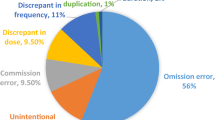Abstract
Purpose
To study differences in outcomes of medication reconciliation (MR) when performed by clinical pharmacists compared to nurses.
Methods
201 patients (21–92 years) admitted to the Department of Cardiology at the University Hospital of North Norway, autumn 2012, were randomized into a pharmacist group (PG) and a nurse group (NG). The nurses and the pharmacists were trained for performing the MR process by an independent clinical pharmacist. Medication discrepancies (MDs) were discussed with the physicians. Time spent during the MR was recorded. An independent expert group rated clinical relevance of the MDs retrospectively.
Results
At least one MD was identified in 78 % and 84 % of patients in PG and NG, respectively (P = 0.269) with a mean number of MDs per patient 3.1 (SD 2.1) and 2.8 (SD 2.2), respectively (P = 0.528). Mean time spent/patient on the MR process was 22.9 min (SD 11.6) in the PG and 32.2 min (SD 20.3) in the NG (P < 0,001). Physicians agreed significantly more often to act upon the MDs presented by pharmacists compared to nurses (P = 0.001). The expert group finally assessed 48 % and 49 % of the MDs to be of the clinical relevance in the PG and the NG, respectively.
Conclusions
By applying a structured method for MR, a small however not statistically significant difference in identified MDs between nurses and clinical pharmacists was revealed. The pharmacists spent significantly less time than the nurses, and physicians agreed significantly more often with the pharmacist that action should be taken on the MDs. This is important in the discussion of who to perform MR.



Similar content being viewed by others
Reference
Tam VC, Knowles SR, Cornish PL, Fine N, Marchesano R, Etchells EE (2005) Frequency, type and clinical importance of medication history errors at admission to hospital: a systematic review. CMAJ 173(5):510–515
Scullin C, Scott M, Hogg A, McElnay J (2007) An innovative approach to integrated medicines management. J Ev Clin Pract 13(5):781–788
Steurbaut S, Leemans L, Leysen T, De BE, Cornu P, Mets T et al (2010) Medication history reconciliation by clinical pharmacists in elderly inpatients admitted from home or a nursing home. Ann Pharmacother 44(10):1596–1603
Midlov P, Bergkvist A, Bondesson A, Eriksson T, Hoglund P (2005) Medication errors when transferring elderly patients between primary health care and hospital care. Pharm World Sci 27(2):116–120
Garasen H, Johnsen R (2007) The quality of communication about older patients between hospital physicians and general practitioners: a panel study assessment. BMC Health Serv Res 7:133
Glintborg B, Andersen SE, Dalhoff K (2007) Insufficient communication about medication use at the interface between hospital and primary care. Qual Saf Health Care 16(1):34–39
Unroe KT, Pfeiffenberger T, Riegelhaupt S, Jastrzembski J, Lokhnygina Y, Colon-Emeric C (2010) Inpatient medication reconciliation at admission and discharge: A retrospective cohort study of age and other risk factors for medication discrepancies. Am J Geriatr Pharmacother 8(2):115–126
Salanitro AH, Osborn CY, Schnipper JL, Roumie CL, Labonville S, Johnson DC et al (2012) Effect of patient- and medication-related factors on inpatient medication reconciliation errors. J Gen Intern Med 27(8):924–932
Mueller SK, Sponsler KC, Kripalani S, Schnipper JL (2012) Hospital-based medication reconciliation practices: a systematic review. Arch Intern Med 172(14):1057–1069
Feldman LS, Costa LL, Feroli ER Jr, Nelson T, Poe SS, Frick KD et al (2012) Nurse-pharmacist collaboration on medication reconciliation prevents potential harm. J Hosp Med 7(5):396–401
The American Society of Health-System Pharmacists (ASHP) (2013) ASHP statement on the pharmacist’s role i medication reconciliation. Am J Health Syst Pharm 70(5):453–456
Randomization service from the Norwegian University of Science and Technology. https://www.ntnu.no/dmf/akf/randomisering. Accessed 2014-03-25
Eriksson T, Holmdahl L, Bondesson Å, Midlov P, Høglund P (2010) Medicin och farmaci i samverkan för bättre läkemedelsansvändning: LIMM-modellen. [Eng. Medicine and Pharmacy in collaboration for better use of medicines: The LIMM-model]. I vården 9:23–27
Norwegian Institute of Public Health. WHO collaboration centre for drug statistics and methodology. http://www.whocc.no/atc_ddd_index/ Accessed 2014-03-25
Cornish PL, Knowles SR, Marchesano R, Tam V, Shadowitz S, Juurlink DN et al (2005) Unintended medication discrepancies at the time of hospital admission. Arch Intern Med 165(4):424–429
Robson C (2002) Real world research. A resource for social scientists and practitioner-researchers, 2nd edn. Blackwell Publishing, Malden
Jones J, Hunter D (1995) Consensus methods for medical and health services research. BMJ 311(7001):376–380
National Institute for Health and Clinical Excellence (2011) Technical patient safety solutions for medicines reconciliation on admission of adults to hospital. NICE patient safety guidance. Accessed 2014-03-25
Acknowledgement
We thank the personnel and patients at the Department of Cardiology at the University hospital of North Norway for all help and collaboration, especially the tree nurses that participated; Jeanette Robertsen, Jenny Vesterhus and Katrine Vollen. We thank MD Richard Slubowski for the help in validating the English-Norwegian translation of clinical relevance criteria and the expert group for rating clinical relevance. We thank Sykehusapotekene i Midt-Norge HF for teaching, help and collaboration regarding the IMM methodology and IMM tools.
Conflict of interest
The authors declare that they have no conflicts of interest to disclose.
Author information
Authors and Affiliations
Corresponding author
Electronic supplementary material
Below is the link to the electronic supplementary material.
ESM 1
(DOCX 33 kb)
Rights and permissions
About this article
Cite this article
Aag, T., Garcia, B.H. & Viktil, K.K. Should nurses or clinical pharmacists perform medication reconciliation? A randomized controlled trial. Eur J Clin Pharmacol 70, 1325–1332 (2014). https://doi.org/10.1007/s00228-014-1741-7
Received:
Accepted:
Published:
Issue Date:
DOI: https://doi.org/10.1007/s00228-014-1741-7




